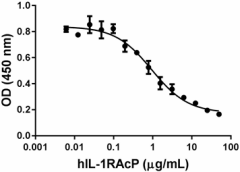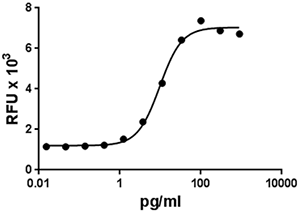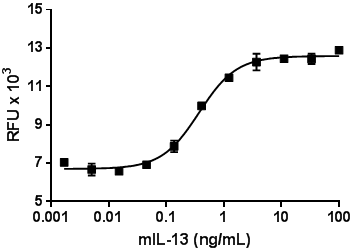- Regulatory Status
- RUO
- Other Names
- Interleukin-1 receptor accessory protein, IL-1 receptor accessory protein, IL-1RAcP, IL-1RAP, interleukin-1 receptor 3, IL-1R3, IL-1R-3
- Ave. Rating
- Submit a Review
- Product Citations
- publications

-

Human IL-1R Accessory protein inhibits the production of IL-8 in human liver carcinoma HepG2 cells induced by recombinant human IL-1α.The ED50 for this effect is 0.8 – 4 µg/mL. -

Stability testing for human IL-1RAcP (IL-1R3). Human IL-1RAcP was aliquoted in PBS at 0.2 mg/mL, and one aliquot was kept at 4°C (control) and another was frozen and thawed four times (4X freeze/thaws). After this procedure, the samples were tested by their property to inhibit the production of IL-8 in human liver carcinoma HepG2 cells induced by recombinant human IL-1α.
IL-1RAcP, also known as IL-1R3, belongs to the IL-1 receptor family. IL-1RAcP consists of an extracellular domain containing three Ig-like C2 type domains, a transmembrane region and a cytoplasmic portion with a TIR (Toll-IL-1-receptor) domain. IL-1RAcP forms a heterodimer with IL-1R1, IL-1RL1 (also known as ST2, IL-1R4), or IL-1Rrp2 (IL-1R6) and functions as a co-receptor for IL-1, IL-33, and IL-36. However, IL-1RAcP does not directly bind to ligands. Upon ligand binding to IL-1R1, IL-1RAcP is recruited to form a high affinity heterodimeric receptor complex. Subsequently, the TIR domains of IL-1R1 and IL-1RAcP recruit the downstream molecules, MyD88, IRAKs and TRAF6 and the signaling cascade is transduced, including NF-κB, MAPK, and JNK pathways. The same mechanisms occur upon IL-33 and IL-36 activation. There are two isoforms identified due to alternative splicing, membrane-bound and soluble forms. Soluble IL-1RAcP is found in mouse liver and the expression levels are regulated by different stimuli, such as phorbol esters. Soluble IL-1RAcP serves as an inhibitor of IL-1 signaling by enhancing binding affinity of soluble IL-1R2 to IL-1. In addition, membrane-bound IL-1R2 inhibits IL-1 signaling by sequestering IL-1 and IL-1RAcP, limiting the availability of IL-1RAcP for engagement of receptor complex. However, IL-1Ra does not bind to IL-1RAcP. Another IL-1RAcP variant, called IL-1R3b or IL-1RAcPb, has been described. The expression is restricted in central nervous system and it modulates neuronal response to IL-1. The dysregulation of IL-1RAcP expression associates with several diseases, such as acute myeloid leukemia (AML) and myelodysplastic syndromes (MDS).
Product DetailsProduct Details
- Source
- Human IL-1RAcP, amino acid (Ser21-Glu359) (Accession: #Q9NPH3) with a C-terminal human IgG1 (Lys100-Pro330), followed by a 6x His tag, was expressed in 293E cells.
- Molecular Mass
- The 580 amino acid recombinant protein has a predicted molecular mass of approximately 66.26 kD. The DTT-reduced and non-reduced protein migrates at approximately 80 kD and 160 kD by SDS-PAGE. The predicted N-terminal amino acid is Ser.
- Purity
- >98%, as determined by Coomassie stained SDS-PAGE.
- Formulation
- 0.22 µm filtered protein solution is in PBS, pH 7.2.
- Endotoxin Level
- Less than 0.1 EU per µg cytokine as determined by the LAL method.
- Concentration
- 10 and 25 µg sizes are bottled at 200 µg/mL. 100 µg size and larger sizes are lot-specific and bottled at the concentration indicated on the vial. To obtain lot-specific concentration and expiration, please enter the lot number in our Certificate of Analysis online tool.
- Storage & Handling
- Unopened vial can be stored between 2°C and 8°C for up to 2 weeks, at -20°C for up to six months, or at -70°C or colder until the expiration date. For maximum results, quick spin vial prior to opening. The protein can be aliquoted and stored at -20°C or colder. Stock solutions can also be prepared at 50 - 100 µg/mL in appropriate sterile buffer, carrier protein such as 0.2 - 1% BSA or HSA can be added when preparing the stock solution. Aliquots can be stored between 2°C and 8°C for up to one week and stored at -20°C or colder for up to 3 months. Avoid repeated freeze/thaw cycles.
- Activity
- The ED50 = 0.8 - 4 µg/mL, as determined by its ability to inhibit human IL-1α (Cat. No. 570002) -induced IL-8 production on human liver carcinoma HepG2 cells in the presence of 1 µg/mL of human IL-1R2 (Cat. No. 767902). Human IL-8 ELISA MAX™ Deluxe Kit (Cat. No. 431504) was used to measure IL-8 production.
- Application
-
Bioassay
- Application Notes
-
BioLegend carrier-free recombinant proteins provided in liquid format are shipped on blue ice. Our comparison testing data indicates that when handled and stored as recommended, the liquid format has equal or better stability and shelf-life compared to commercially available lyophilized proteins after reconstitution. Our liquid proteins are verified in-house to maintain activity after shipping on blue ice and are backed by our 100% satisfaction guarantee. If you have any concerns, contact us at tech@biolegend.com.
Antigen Details
- Structure
- Cytokine receptor
- Distribution
-
Ubiquitously expressed in all cells responsive to IL-1, including T cells, fibroblasts, endothelial cells, epithelial cells, monocytes, dendritic cells, cardiomyocytes; plasma membrane
- Function
- IL-1RAcP is a co-receptor for IL-1, IL-33 and IL-36. It is required for downstream signaling. The soluble form of IL-1RAcP serves as an inhibitor of IL-1 signaling.
- Ligand/Receptor
- IL-1R1, IL-1R2, IL-1RL1, IL-1Rrp2
- Cell Type
- Hematopoietic stem and progenitors
- Biology Area
- Cancer Biomarkers, Cell Biology, Immunology, Stem Cells
- Molecular Family
- Soluble Receptors
- Antigen References
-
- Greenfeder SA, et al. 1995. J Biol Chem. 270:22460
- Boraschi D, et al. 2013. Semin Immunol. 25:394
- Towne JE, et al. 2004. J Biol Chem. 279:13677
- Greenfeder SA, et al. 1995. J Biol Chem. 270:13757
- Wesche H, et al. 1997. J Biol Chem. 272:7727
- Liu X, et al. 2013. Proc Natl Acad Sci USA. 110:14918
- Yoon DY, et al. 1998. J Immunol. 160:3170
- Jensen LE, et al. 2003. Cell Signal. 15:793
- Jensen LE, et al. 2000. J Immunol. 164:5277
- Smith DE, et al. 2003. Immunity. 18:87
- Smith DE, et al. 2009. Immunity. 30:817
- Barreyro L, et al. 2012. Blood. 120:1290
- Gene ID
- 3556 View all products for this Gene ID
- UniProt
- View information about IL-1RAcP on UniProt.org
Related FAQs
- Why choose BioLegend recombinant proteins?
-
• Each lot of product is quality-tested for bioactivity as indicated on the data sheet.
• Greater than 95% Purity or higher, tested on every lot of product.
• 100% Satisfaction Guarantee for quality performance, stability, and consistency.
• Ready-to-use liquid format saves time and reduces challenges associated with reconstitution.
• Bulk and customization available. Contact us.
• Learn more about our Recombinant Proteins. - How does the activity of your recombinant proteins compare to competitors?
-
We quality control each and every lot of recombinant protein. Not only do we check its bioactivity, but we also compare it against other commercially available recombinant proteins. We make sure each recombinant protein’s activity is at least as good as or better than the competition’s. In order to provide you with the best possible product, we ensure that our testing process is rigorous and thorough. If you’re curious and eager to make the switch to BioLegend recombinants, contact your sales representative today!
- What is the specific activity or ED50 of my recombinant protein?
-
The specific activity range of the protein is indicated on the product datasheets. Because the exact activity values on a per unit basis can largely fluctuate depending on a number of factors, including the nature of the assay, cell density, age of cells/passage number, culture media used, and end user technique, the specific activity is best defined as a range and we guarantee the specific activity of all our lots will be within the range indicated on the datasheet. Please note this only applies to recombinants labeled for use in bioassays. ELISA standard recombinant proteins are not recommended for bioassay usage as they are not tested for these applications.
- Have your recombinants been tested for stability?
-
Our testing shows that the recombinant proteins are able to withstand room temperature for a week without losing activity. In addition the recombinant proteins were also found to withstand four cycles of freeze and thaw without losing activity.
- Does specific activity of a recombinant protein vary between lots?
-
Specific activity will vary for each lot and for the type of experiment that is done to validate it, but all passed lots will have activity within the established ED50 range for the product and we guarantee that our products will have lot-to-lot consistency. Please conduct an experiment-specific validation to find the optimal ED50 for your system.
- How do you convert activity as an ED50 in ng/ml to a specific activity in Units/mg?
-
Use formula Specific activity (Units/mg) = 10^6/ ED50 (ng/mL)
 Login / Register
Login / Register 











Follow Us